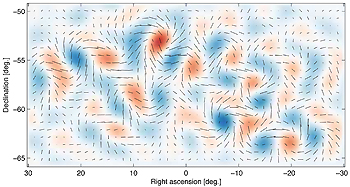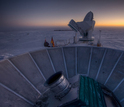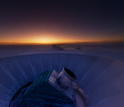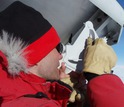News Release 14-036
NSF-funded researchers say Antarctic telescope may have provided the first direct evidence of cosmic inflation and the origins of the universe
Uniquely cold and dry conditions of the atmosphere over Antarctica's polar plateau made the observations possible

The actual B-mode pattern observed with the BICEP2 telescope.
March 17, 2014
This material is available primarily for archival purposes. Telephone numbers or other contact information may be out of date; please see current contact information at media contacts.
Researchers with the National Science Foundation-funded BICEP2 Collaboration today announced that their telescope in Antarctica has allowed them to collect what they believe is the first direct evidence for cosmic inflation.
Inflation is the cataclysmic event in which, in a fleeting fraction of a second following the Big Bang, the infant universe expanded exponentially, stretching far beyond the view of the best telescopes.
Modern astronomy is built around the theory that almost 14 billion years ago, the universe burst into existence in an extraordinary event that initiated the Big Bang, which was then followed by the superluminal inflation of spacetime that created the current universe as we know it.
But until the BICEP results were announced, all of the scientific conjecture on inflation was built solely on a solid theoretical framework. Now, using data gathered by an NSF-funded telescope located at the geographic South Pole, the collaboration has described what it says are the first direct, observational evidence of inflation.
The findings, the collaboration's researchers believe, also represent the first images of gravitational waves or ripples in spacetime, and confirm a deep connection between quantum mechanics and general relativity. These waves have been described as the "first tremors of the Big Bang."
"Detecting this signal is one of the most important goals in cosmology today. A lot of work by a lot of people has led up to this point," said John Kovac, of the Harvard-Smithsonian Center for Astrophysics, the leader of the BICEP2 collaboration, which is funded by the Division of Polar Programs in NSF's Geosciences Directorate and NSF's Division of Astronomical Sciences in the Directorate for Mathematical and Physical Sciences.
Through the Division of Polar Programs, NSF manages the U.S. Antarctic Program, which coordinates all U.S. research on the southernmost continent and the complex logistics required to support the science.
The results were announced at a press conference at 11:55 a.m. today.
A technical presentation preceded the press conference.
BICEP2 is the second stage of the NSF-funded collaborative program. Harvard University and the Keck Foundation also contributed funding for the construction of the team's telescopes at Amundsen-Scott South Pole Station, which is one of three year-round U.S. Antarctic Program research stations.
In addition to Kovac, the NSF-funded principal investigators for the BICEP2 project are Clem Pryke of the University of Minnesota; Jamie Bock of the California Institute of Technology's Jet Propulsion Laboratory; and Chao-Lin Kuo of the Stanford Linear Accelerator Center.
Other major collaborating institutions for BICEP2 include the University of California, San Diego; the University of British Columbia; the National Institute of Standards and Technology; the University of Toronto; Cardiff University; and France's Commissariat à l'Energie Atomique.
In addition to NSF support for BICEP, NASA's Jet Propulsion Laboratory and the Moore Foundation supported the development of the ultra-sensitive detector arrays, which made the measurements possible.
The team examined spatial scales on the sky spanning about one to five degrees (two to ten times the width of the full Moon). To do this, they traveled to the South Pole Station to take advantage of the cold, dry, stable air over Antarctica's Polar Plateau, which rises thousands of meters above sea level.
"The South Pole is the closest you can get to space and still be on the ground," said Kovac. "It's one of the driest and clearest locations on Earth, perfect for observing the faint microwaves from the Big Bang."
The groundbreaking results came from observations by the BICEP2 telescope of the cosmic microwave background -- a faint glow left over from the Big Bang. Tiny fluctuations in this afterglow provide clues to conditions in the early universe.
For example, small differences in temperature across the sky show where parts of the universe were denser, eventually condensing into galaxies and galactic clusters.
Since the cosmic microwave background is a form of light, it exhibits all the properties of light, including polarization. On Earth, sunlight is scattered by the atmosphere and becomes polarized, which is why polarized sunglasses help reduce glare. In space, the cosmic microwave background was scattered by atoms and electrons and became polarized too.
"Our team hunted for a special type of polarization called 'B-modes,' which represents a twisting or 'curl' pattern in the polarized orientations of the ancient light," said Bock.
Gravitational waves squeeze space as they travel, and this squeezing produces a distinct pattern in the cosmic microwave background. Gravitational waves have a 'handedness,' much like light waves, and can have left- and right-handed polarizations.
"The swirly B-mode pattern is a unique signature of gravitational waves because of their handedness. This is the first direct image of gravitational waves across the primordial sky," said Kuo.
The researchers were surprised to detect a B-mode polarization signal considerably stronger than many cosmologists expected. The team analyzed their data for more than three years in an effort to rule out any errors. They also considered whether dust in our galaxy could produce the observed pattern, but the data suggest this is highly unlikely. "This has been like looking for a needle in a haystack, but instead we found a crowbar," said Pryke.
Vladimir Papitashvili, the U.S. Antarctic Program's astrophysics and geospace sciences program director, said "the South Pole is an excellent place for Cosmic Microwave Background observations during the long, dark, and very cold winter. It reflects well on the NSF/USAP-supported BICEP team that they are now able to bring forward, for the first time, this long-awaited B-mode polarization signal so that their work can be examined by the broader astrophysics community."
Asked to comment on the implications of this discovery, Harvard theorist Avi Loeb said, "this work offers new insights into some of our most basic questions: Why do we exist? How did the universe begin? These results are not only a smoking gun for inflation, they also tell us when inflation took place and how powerful the process was."
Technical details and journal papers can be found on the BICEP2 release website. The BICEP2 results will be submitted to a peer-reviewed journal for publication.
-NSF-
-
The sun sets behind BICEP2 and the South Pole Telescope at NSF's Amundsen-Scott South Pole Station.
Credit and Larger Version -
The sun sets behind BICEP2 and the South Pole Telescope.
Credit and Larger Version -
View Video
NSF-funded BICEP2 collaborators announce confirmation of cosmic inflation.
Credit and Larger Version
Media Contacts
Peter West, NSF, (703) 292-7530, email: pwest@nsf.gov
Christine Pulliam Pulliam, Harvard-Smithsonian Center for Astrophysics, (617) 495-7463, email: cpulliam@cfa.harvard.edu
B-Roll Contacts
Dena Headlee, NSF, (703) 292-7739, email: dheadlee@nsf.gov
Principal Investigators
John Kovac, Harvard University, (617) 496-0611, email: jmkovac@cfa.harvard.edu
The U.S. National Science Foundation propels the nation forward by advancing fundamental research in all fields of science and engineering. NSF supports research and people by providing facilities, instruments and funding to support their ingenuity and sustain the U.S. as a global leader in research and innovation. With a fiscal year 2023 budget of $9.5 billion, NSF funds reach all 50 states through grants to nearly 2,000 colleges, universities and institutions. Each year, NSF receives more than 40,000 competitive proposals and makes about 11,000 new awards. Those awards include support for cooperative research with industry, Arctic and Antarctic research and operations, and U.S. participation in international scientific efforts.
Connect with us online
NSF website: nsf.gov
NSF News: nsf.gov/news
For News Media: nsf.gov/news/newsroom
Statistics: nsf.gov/statistics/
Awards database: nsf.gov/awardsearch/
Follow us on social
Twitter: twitter.com/NSF
Facebook: facebook.com/US.NSF
Instagram: instagram.com/nsfgov





